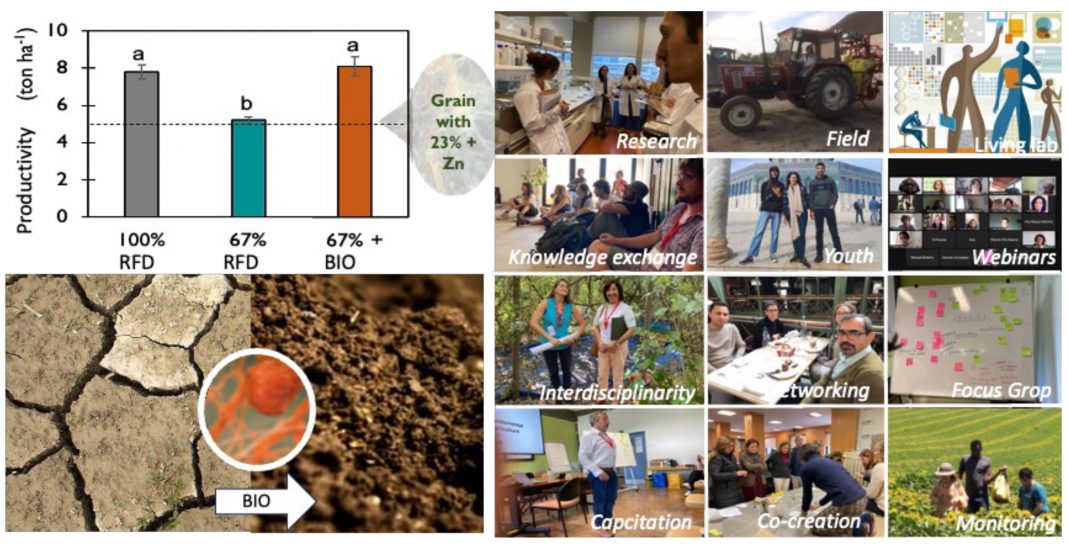Cristina Cruz and Teresa Dias from Faculdade de Ciências da Universidade de Lisboa, focus on biostimulants, which are more than a product, but a significant change towards sustainable food production systems
According to the European Union (EU), a biostimulant is a product that stimulates plants’ nutrition processes independently of the product’s nutrient content by improving:
- Nutrient use efficiency.
- Tolerance to abiotic stress.
- Quality traits.
- Availability of poorly soluble nutrients. (1)
Although a biostimulant is better defined by its function in the plant than by its content, it is usually composed of microorganisms (dead or alive) and/or products of their metabolism.
Policy around biostimulants
At least in the EU, there is a clear political framework (e.g., Farm to Fork strategy, Biodiversity strategy, European Green Deal, Healthy Soils for Europe) to reduce the use of chemical fertilizers and pesticides. As a result of the EU’s and other world regions’ ambitions, the global biostimulants market is expected to almost triple in the coming seven years (i.e., increase from 3.2 billion dollars in 2023 to more than 9.0 billion dollars in 2030 – Dunham Trimmer Global Biostimulant Market report).
The biostimulants industry is among the fastest growing and most attractive segments in agriculture, and its main drivers include the demand for sustainability (a market driver), the demands related to climate change, stagnant yields, and increased knowledge on soil ecology and plant nutrition.
However, biostimulants’ contribution to the global “One Health” concept has been overlooked, mainly due to oversimplifying their mode of action. Biostimulants are products able to regenerate the functionality of very degraded soils by revitalizing the soil food web, decreasing farming ecological footprinting due to a reduction in the amount of fertilizer and pesticides, and improving crop quality by increasing their mineral content (among other mechanisms).
Integrate biostimulants with other farming practices
In the BioClub project (supported by Portuguese funds through Fundação para a Ciência e a Tecnologia, reference PTDC/AGR PTDC/AGR-PRO/1852/2014), we demonstrated that the use of biostimulants composed of a microbial consortium of bacteria and mycorrhizal fungi was able to compensate for a 33% reduction in the recommended dose of chemical fertilizers, i.e., crop productivity (maize) was similar to that obtained with the recommended dose of chemical fertilizers. Furthermore, the grain produced was enriched in zinc and iron by 20%, which may be a relevant contribution to diminish the deficiency of these nutrients in the human diet (Fig 1).
For all these reasons, biostimulants should be listed alongside other sustainable farming practices like crop rotation, cover cropping, conservation tillage, agroforestry, integrated pest management, organic farming, or agroecology.
Furthermore, we must highlight that the use of biostimulants is compatible and can integrate with other farming practices ranging from agroecology to smart farming, according to the specific local context (Cruz and Dias, 2023 – https://doi.org/10.56367/OAG-040-10978).
Integrating biostimulants as a regular agricultural practice promotes sustainability by enhancing nutrient availability, improving soil health and reducing farming’s environmental impact. However, it is essential to note that biostimulants’ effectiveness can vary depending on factors like soil type, climate, and crop species. Therefore, the application of biostimulants should be carefully tailored to specific agroecosystems, and their use and results should be discussed using a multiactor approach.
For example, the living labs use a multiactor approach, where biostimulants and their system effects can be used and studied under real-world agricultural conditions. Once in the hands of the farmers, the biostimulant will be applied to the field and integrated into a programme involving fertilizers, pesticides, and other product applications. This and the recommended dosage and application methods (foliar spraying, seed treatment, or soil application, depending on the type of biostimulant and the target crops) must be discussed among researchers, producers, technicians, and politicians.
The impact of biostimulant Application
Monitoring the effects of biostimulant application is crucial for farmers to understand the advantages of using this type of product, which may produce more benefits in years of increased stress conditions (e.g., droughts and heat waves). Usually, monitoring the effects of biostimulants focuses on plant growth parameters, including height, biomass, flowering, and fruiting. Since biostimulants may also influence nutrient availability and microbial communities (leading to enhanced nutrient cycling and improved soil health), monitoring the plant and the soil will provide the living lab community with the data needed to adjust management to sustainability.
Biostimulants: Economic and environmental impacts
Besides plant- and soil-focused monitoring, it is also necessary to evaluate the economic and environmental implications of using biostimulants, including cost-benefit analyses, assessments of resource use efficiency, and broader sustainability implications. In this context, the knowledge gained from biostimulant studies can be shared through extension services, workshops, and publications, facilitating adoption of sustainable and effective agricultural practices.
Using biostimulants in agriculture
By using biostimulants in a living lab context, researchers can generate and share valuable insights into the practical applications of these products, contributing to developing sustainable and resilient agricultural practices.
Using biostimulants in agriculture is more than using a product; it is a knowledge- and nature-based solution towards farming sustainability and One Health.
Reference

This work is licensed under Creative Commons Attribution-NonCommercial-NoDerivatives 4.0 International.


